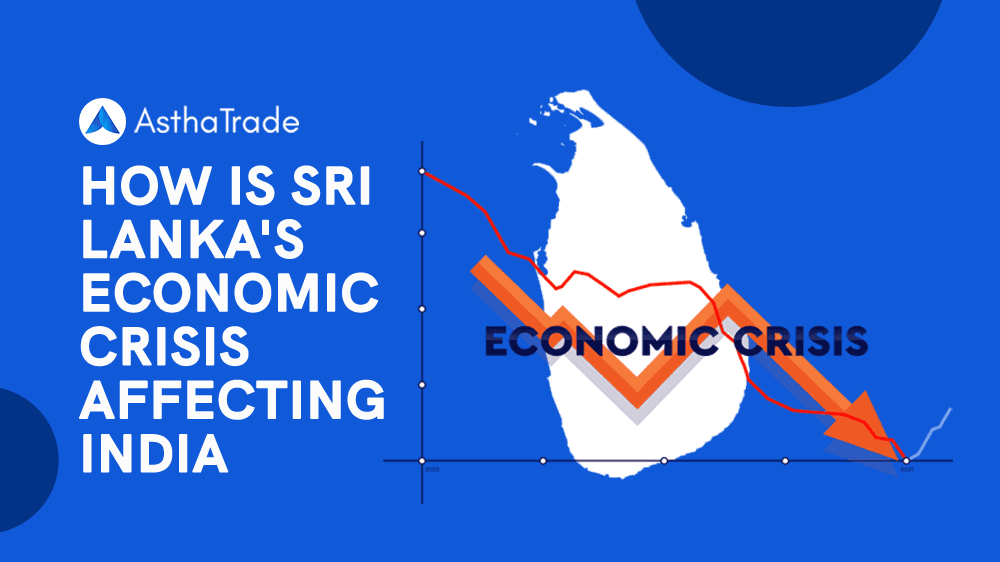Exploring the Consequences of SriLanka’s Economic Crisis on India


00:00 / 00:00
Introduction
Sri Lanka is facing the worst economic crisis since independence. How are the resulting migrant challenges and economic dependence of Sri Lanka affecting India?
While a prosperous and well-fed neighbour is harmonious and causes fewer problems, having an unstable one might cause unrest in your household.
The same is true with countries around the world.
The 2 most significant events that have threatened the world markets with excessive inflation and supply chain disruption.
Over the last two years are the COVID-19 pandemic and Russia Ukraine war.
Although both of these events have caused panic globally, many countries have drowned in the economic crisis caused by these events.
One such event is the Sri Lanka economic crisis. This blog covers how the Sri Lankan economy suffers due to the above events and their effects on India.
How Was Sri Lanka Driven Into the Crisis?
Being primarily hit by the travel restrictions during the COVID-19 lockdowns, Sri Lanka lost most of its tourism industry, which was the backbone of its economy. Is this the entire picture?
How Sri Lanka lost control of its economy
Lousy Governance
Many factors that caused bad governance in Sri Lanka include the following:
- Mismanaged Government Finances
- Ill-times tax cuts
- Devalued Currency
As a result, debt started piling up, and the government treasury started to empty.
Sri Lankans purchase most of their consumer items from abroad. This means that the government was facing a trade deficit with foreign countries.
The Collapse of the Tourism Industry
The collapse of the Tourism Industry: Being one of the most important industries, tourism constituted more than 12% of Sri Lanka’s GDP.
Due to the pandemic-induced lockdowns and travel restrictions, the Sri Lankan economy lost its balance.
Forex Reserves
Due to the negative trade balance with foreign countries, the net forex reserves of Sri Lanka dipped to around USD 2 billion, which is not enough to purchase even the essentials for the citizens.
Hence, the country is experiencing broad-scale power cuts and a shortage of food supplies.
Building up External Debt
The external debt of the Sri Lankan government is almost 119% of its annual GDP. This means that the country’s resources are insufficient to repay its existing debts.
Let alone the new borrowings needed to sustain the population. Hence, the cost of essentials has skyrocketed, making people vulnerable.
Hit to Exports and Imports
Sri Lanka is a significant exporter of tea to Russia and Ukraine, and it purchases almost 50% of its wheat and sunflower oil from these countries.
Due to the ongoing Russia-Ukraine war, the already suffering economy faces another wide-scale crisis.
How is India Being Affected by Sri Lanka’s Crisis?
Unprecedented Aid
The amount of humanitarian aid and multiple lines of credit extended by India to Sri Lanka since last year is unprecedented. Indeed, it is causing a dent in India’s budget.
Chinese Threat
The Chinese government is eyeing an opportunity to take advantage of the Sri Lankan crisis to gain power in the Indian Ocean.
Having already acquired the ownership of Hambantota Port, the increasing Chinese threat is compelling India to save Sri Lanka from this crisis.
Migration Pressure
The southern coast of India is experiencing a consistent infiltration by the Sri Lankan citizens eyeing to take refuge in India during the crisis.
While Sri Lanka is experiencing a Stock Market Crash, the Indian markets are primarily stable.
This is due to the government’s policy to encourage Make in India and other critical industrial reforms.
Textile, metals & steel, ships and boats, capital goods are the major exports from India to Sri Lanka.
So those Indian companies having high export to Srilanka in these segments are likely to to be hit.
It is also an opportunity for the Indian textile industry to capture the market being served by Srilanka, currently.
The content on this blog is for educational purposes only and should not be considered investment advice. While we strive for accuracy, some information may contain errors or delays in updates.
Mentions of stocks or investment products are solely for informational purposes and do not constitute recommendations. Investors should conduct their own research before making any decisions.
Investing in financial markets are subject to market risks, and past performance does not guarantee future results. It is advisable to consult a qualified financial professional, review official documents, and verify information independently before making investment decisions.






